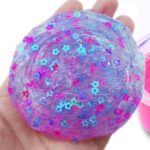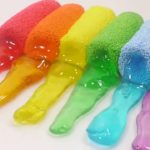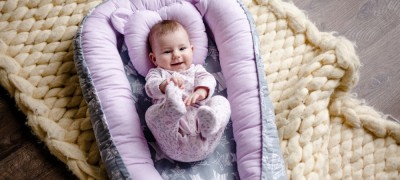Slime recipes (slime) from improvised means
A funny toy for children and adults under the original name "slime" appeared on the territory of the CIS more than 20 years ago and took root in Russia under the name "slime". The toy is a plastic-like ball, which at rest spreads over the surface, and with strong compression and impact on it, it becomes rigid and elastic. The material of the slime allows you to make many different manipulations with the toy.

You can wrinkle a slime in your hand, sculpt self-destructive (spreading) figures, blow bubbles on the table with a straw or the body of a fountain pen, throw bubbles at the wall and watch it slowly slide to the floor. The material "slime" does not stain hands, clothes or walls of the house, but it tends to absorb dust and small particles. Therefore, American housewives appreciated "slimes" not only as a toy, but also as an item for easy cleaning of hard-to-reach places and electronic devices (remotes, keyboards, etc.).

Due to their anti-stress qualities, slimes have gained wide popularity among residents of Russian cities, whose dynamic rhythm of life requires constant psychological relaxation. For children, in addition to developing hand motor skills, slimes help to enhance such important personal qualities as imagination, ingenuity and creativity.
- How to make a slime from improvised means
-
Homemade "slimes". Types and recipes
-
How to make a slime from PVA glue
- PVA glue and soda
- Slime from PVA and shampoo or liquid soap
- PVA and toothpaste. Very runny slime
- Adding salt to recipes with PVA glue
- Adding glycerin to slime
- How to make shampoo slime
- Fluffy slime
- Fragrant and airy slime
- Crispy slime made from shampoo, soap and glue
- Heavy slime
- How to make slime from shampoo and flour
- How to make a slime from laundry soap
- Starch based recipes
- Plasticine slime
- Powder slime for washing
- Slime from paste
- Hand Cream Slime
-
How to make a slime from PVA glue
- Afterword
- VIDEO: How easy it is to make a slime with your own hands.
- 50 options for beautiful bright do-it-yourself slimes:
How to make a slime from improvised means
The composition, structure and additional properties of slime are very diverse. Slime slimes are liquid, viscous, magnetic, crunchy, glossy, transparent, bubbly and even without chemical ingredients in the composition. But at the same time, the two main components of any slime are polymer and thickener. At home, a slime is made at normal room temperature in a glass or ceramic container. Titanium cookware is also suitable. It is not recommended to use plastic or aluminum dishes because they enter into an imperceptible reaction with the thickener.

Some components, when creating slimes, show slight toxicity, and the dishes after them need to be thoroughly washed. It is better not to violate the recommended filling technology, otherwise large molecules may not gather into spatial structures, which give this material its unusual properties. The proportions of ingredients are more advisory in nature, and each type of "slime" has its own individual recipe.Below are descriptions and step-by-step instructions for creating homemade "slimes".
How to make liquid slime
The classic recipe for liquid slime recommends using 100 g of guar gum (polymer) and 1 teaspoon (15 g) of sodium tetraborate (thickener) per 100 ml of water. The ingredients are easy to obtain: guar gum is sold freely both as a food supplement and as a component for cosmetics. Sodium tetraborate, also known as borax, is available over the counter in pharmacies. Any dye is used. After the polymer and thickener are purchased, you need to select 2 suitable containers, a strainer for sifting the gum, a teaspoon and a stirring rod. Then the water is heated to a warm state ("borax" and a number of other thickeners do not dissolve in cold water). Then you can start creating a "slime" according to the following scheme:
- 100 g of gum is sifted into the first container (cup, bowl).
- A second larger container is poured with 100 ml of warm water.
- Having scooped up the sifted gum with a teaspoon, a portion of this polymer is added to the water through a strainer held over a second bowl. Stir after each portion.
- A couple of drops of dye are added. If the dye is in a powder state, then it is preliminarily diluted with water. The main condition is not to add excessive amounts of dye. This will not greatly affect the color, but the material will start to stain everything around with paint.
- A thickener ("borax") is poured into a teaspoon and little by little added to the stirring solution. Stir the mixture thoroughly until thickened. If, when viscosity appears, the material does not stretch well, you must add a couple of drops of 6% vinegar. With the help of the polymer, the dilution of the solution is regulated, and the thickeners are responsible for the density of the "slime"
- If no thickening occurs, it means that the water is not warm enough for "borax". You can heat the container in the microwave. You can also pour 100 ml of hot water, stir and add the polymer and thickener in the same proportions.
- If a lump of "slime" sticks strongly to your hands, you need to add 2-3 drops of hydrogen peroxide and press it into the structure. With poor sliding in the hands, add a couple of drops of glycerin.
- The finished "slime" is placed in an airtight container (jar, bottle) and placed on the bottom shelf of the refrigerator. After each game, the surface of the slime is sprinkled with water right in the jar and sprinkled with a pinch of salt. Homemade "slime", with proper care, retains its working properties for up to two weeks.

This was the basic recipe. Other combinations of "slime" have their own characteristics, but the essence is always the same: the creation of a material from a polymer base and a thickener that has the characteristics of a non-Newtonian liquid.
How to make a magnetic slime
"Slime" with iron dust has the property of reaching for magnets, as if coming to life on the table. To create a magnetic "slime", an element such as iron is added to the classic formula. It is enough to add 2 teaspoons of iron filings or iron oxide to the proportions (100 ml of water per 100 g of polymer and 15 g of thickener). An additional component is laid out in the finished "slime" according to the scheme:
- An iron portion is placed in the center of the flattened "slime" and closed like a filling in a dough.
- The lump is kneaded well with your hands to a monochromatic, slightly darkened color. The material does not give off the particles that have got into it poorly, and the iron dust is spread over the entire surface.

++ 9 + 9Sometimes, iron shavings, which are larger than sawdust, are used for self-production of magnetic "slime". In this case, the additional ingredient is laid at the initial stage of manufacturing in a common mixture with the polymer. But at the same time, it is necessary to ensure that all particles of the shavings are not sharp or prickly.
How to make a slime without chemistry
Preschool children instinctively strive to taste everything around them. So that the fun with the "slime" does not turn into unpleasant consequences, there are short-lived, but at the same time more safe for the child "slimes" from food components. There are several "edible" slime recipes that are made safe by ingredients such as starch, soda, food colors, and flour.
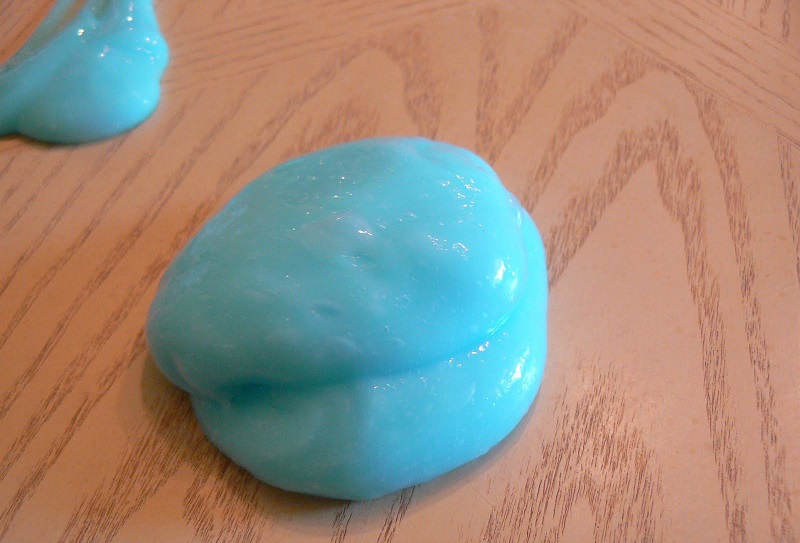
Homemade "slimes". Types and recipes
How to make a slime from PVA glue
Polyvinyl acetate (PVA) is a good basic component that, together with a thickener, gives the slimes a special softness and elasticity. Below are "slimes" based on liquid PVA.
PVA glue and soda
To create you will need: about 100 ml of PVA, 5 g of soda (half a teaspoon), two containers and a mixing stick, a pinch of dye and a micro container for it (a lid, for example). Manufacturing instruction:
- In the first container, mix a glass of warm water (200 ml) with a portion of soda (5 g) until completely dissolved.
- Stir the dye in the microcontainer. If you have ready-made liquid paint or gouache, you can use them instead of powder dye.
- Shake the bottle with PVA and pour into a second container.
- Add a couple of drops of dye and stir until color is uniform.
- Scoop up a teaspoon of baking soda solution and, stirring occasionally, pour a portion into the glue mass.
- Stir at medium speed for a few minutes. Repeat the procedure until the desired density.
- Place the finished slime in the refrigerator for a few hours.

Slime from PVA and shampoo or liquid soap
This is an easy way to make a liquid toy and will require:
- one container and a mixing stick;
- 100 ml PVA;
- 30 ml shampoo or liquid soap.
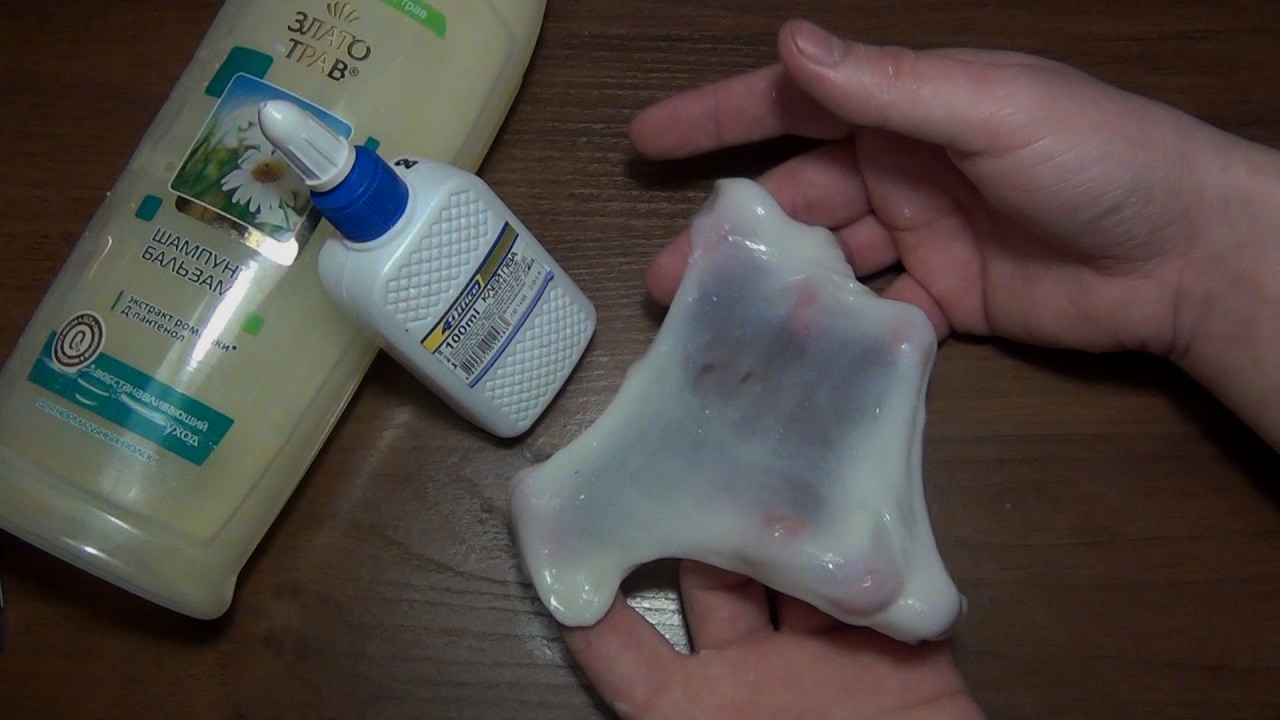
No water is used. The shampoo acts as a thickener, which is added dropwise to the stirring adhesive mass. An additional portion of shampoo is added for greater firmness. It is better to add the colorant before the thickener. The shampoo can be easily replaced with another detergent (liquid soap) or shaving foam, which is used in the same proportions.
PVA and toothpaste. Very runny slime
This method is also considered simple, but it does not always work out.
You will need: dishes, a stirring stick, a bottle of PVA glue (125 ml), a tube of cheap toothpaste and a dye.

First of all, we squeeze the toothpaste into the container and stir it slightly, evenly filling the bottom with the paste. Pour glue on top and mix thoroughly. Add dye. Mix thoroughly again. The resulting mass is covered with a lid or cling film and left alone for two days at room temperature. A slow reaction will itself thicken the components into a non-Newtonian fluid.
Adding salt to recipes with PVA glue
Salt crystals act as an activator that stabilizes the chemical processes in the adhesive. Salt is best used in combination with glue, baking soda and water. Excessive dosage of salt in adhesives leads to a strong dilution of the toy.

Adding glycerin to slime
Glycerin does not have the necessary properties to be used as a main component. But at the same time, it gives the slimes an excellent shine and smoothness. Glycerin is added in proportions of 5 drops per 100 ml of polymer base.

How to make shampoo slime
Shampoos can act not only as a thickener, but also as the main component of slime.This is explained by the fact that there are different compounds in the detergent formula, which actively manifest themselves only based on the proportions of mixing with other components of the slime.

Fluffy slime
You will need: 2 bowls, a stick.
Ingredients: shampoo, shaving gel, deodorant, soda, salt.
Step-by-step instruction:
- 60 ml of shampoo (two tablespoons) are mixed in a bowl with 60 ml of gel.
- Dye is added (if required).
- The resulting mass is sprayed with several volleys of deodorant, mixed and placed in the refrigerator.
- Before extraction into heat, a solution is prepared in the proportion: 2 tbsp. l. salt for 2 tbsp. l. soda per 100 ml of water.
- Knead the mass in a bowl with your hands, gradually pouring a solution on top.

Fragrant and airy slime
Ingredients: 4 tbsp. l. shampoo, 3 tsp PVA, one teaspoon of soda and washing gel.
- Mix shampoo with baking soda.
- Pour the glue in three portions, stirring after each.
- Add washing gel and stir.
- Knead until thick, first with a spoon (stick), then with your hands.

Crispy slime made from shampoo, soap and glue
Ingredients: 100 ml of shampoo, 100 ml of stationery glue, 30 ml of liquid soap, 1 tsp of toothpaste. 10 drops of sodium tetraborate (borax).
Step-by-step instruction:
- Mix glue with shampoo in a bowl.
- Add liquid soap and stir.
- Flatten the toothpaste on a spoon and scrape it into a bowl with a solution. To stir thoroughly.
- Stirring the mass continuously, add one drop of tetraborate to it every three minutes.
- Knead with your hands and place in the refrigerator.

Heavy slime
Ingredients: 50 ml of thick shampoo, 5 ml of liquid soap (5 doses), 10 tablespoons of ground sugar (or just powdered sugar.).
Recommended course of action:
- Mix shampoo and soap in a bowl.
- Slowly in the center of the dish, stirring the solution, pour a portion of sugar with a spoon.
- When thickening, continue to add sugar, kneading the mass with your hands. If too thick, it can be diluted with portions of shampoo and soap.
- Put in the refrigerator for half an hour.

How to make slime from shampoo and flour
Ingredients: 60 ml shampoo, dye, 60 g flour, 1 tsp. hydrogen peroxide and a little oil to care for delicate skin.
Step-by-step instruction:
- Mix shampoos with dye in a bowl.
- While stirring, drip peroxide from a spoon. To stir thoroughly.
- Cover with a lid or foil and send to the freezer for 5 minutes.
- Slowly cover the mixture with flour.
- Knead until it sticks to your hands.
- Leave at room temperature for a day.
- After waiting for a while, grease your hands with oil and knead the resulting slime well.

How to make a slime from laundry soap
You will need: 2 bowls, a mixing stick, a bar of laundry soap, stationery glue, PVA glue, shampoo, soda, washing gel.
Instructions:
- Grate the laundry soap into a bowl or finely cut with a knife.
- Pour the grated soap into 50 ml of warm water. Stir until completely dissolved.
- Pour shampoo into a second bowl and add 0.5 tsp. soda. Interfere.
- Stirring with a stick, add 1 tsp to the shampoo in turn. PVA glue and the same amount of stationery glue.
- Pour the glue mixture with soapy water. To stir thoroughly.
- Sprinkle another 0.5 tsp on top. soda and stir.
- Add 0.5 tsp. gel for washing.
- Knead the mass with a stick and with your hands until the desired thickening.

Starch based recipes
Soft and elastic slime
Ingredients: 4 tbsp. l. starch, 20 ml of toothpaste and 1 teaspoon of shampoo and liquid soap.
Instructions:
- Mix shampoo and soap toothpaste into a single mass.
- While stirring the mass, sprinkle the starch on top in portions.
- Knead the mass well with your hands.

Smooth slime
Ingredients: 3 tbsp. l. starch, 4 tbsp. l. water, 2 tbsp. l spoon of silicate glue, 4 drops of sodium tetraborate.
Manufacturing Guide:
- Pour the starch into a bowl with a slide and cover with warm water. Stir thoroughly until a homogeneous semi-liquid mass. In case of insufficient solubility, you can add another teaspoon of water.
- Pour in silicate glue while stirring.
- Add tetraborate from the vial in a few drops.
- Knead until thickened with a spoon, and then with your hands.

Plasticine slime
To create you will need: 200 ml of water, 20 g of gelatin, 50-100 g of plasticine.
Manufacturing instruction:
- Dissolve 150 ml (from 200 ml) of water in a deep iron container together with gelatin. Leave alone for an hour.
- Plasticine must be kneaded for a long time, sprinkling with the remaining 50 ml of water.
- The gelatin swollen after an hour must be heated, stirring over low heat. The gelatinous particles will gradually dissolve, but the liquid should not boil.
- When the gelatin solution cools down, it is necessary to pour the liquefied plasticine into another container with it. Mix well.
- Place the plasticine-gelatin mass in the refrigerator for an hour.

Powder slime for washing
You will need: washing powder, PVA glue, shaving foam, dye.
Instructions:
- Dissolve 2 tbsp in filtered hot water (200 ml). washing powder. Leave alone for ten minutes.
- In a glass container, 50 ml of PVA glue and 2 tbsp are mixed. shaving foam and dye.
- The powder solution is added in a volume equal to the mass in the glass container. Stir for five minutes.
- Pour out the rest of the powder solution and stir quickly. Floating clots and lumps form on the surface.
- Collect all the clots in a separate bowl, glue them together and knead.
- If you fail to thicken, add a drop of boric acid.

Slime from paste
This type of slime is made from natural ingredients and is absolutely safe for preschool children.
Ingredients: flour for baking, cold and almost hot water, food colors.
Instructions:
- Sift 300 g of flour into a separate bowl.
- Gently pour 50 ml of cold water over the flour, as if irrigating the field.
- Pour 50 ml of very warm water in the same way.
- Stir for a long time and thoroughly until smooth.
- Pour a pinch of food coloring into the resulting paste and mix well again.
- Refrigerate for 6 hours.

Hand Cream Slime
Ingredients: hand cream, soda, dishwashing gel, dye. Instructions for creating:
- 2 tsp mix the gel for dishes in a separate container with 1 tsp. soda. This will be the thickener.
- Squeeze the hand cleaner into a teaspoon and scrape it into a container with a thickener. We mix. We repeat the procedure three times. In total, three tablespoons of hand cream will fall into the thickener.
- Add the dye and knead for a long time until smooth.
- We place in a mild cold (lower shelf of the refrigerator). We withstand a day.

Afterword
Having begun their victorious path around the world, lizuns enchant children and adults with their variety of properties and inner qualities.At home, in addition to dye, glitter, beads, colored powder can be added to slimes. You can pour slimes into bottles and arrange funny pranks. Inventions like slimes relieve stress for adults, give a unique palette of emotions to children and make them look at the world around us in more rainbow colors.

VIDEO: How easy it is to make a slime with your own hands.














